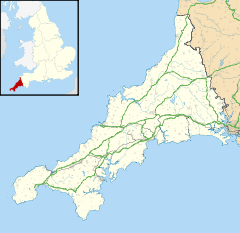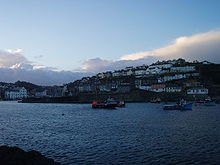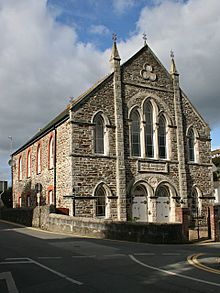- Mevagissey
-
Not to be confused with Menagissey.
Coordinates: 50°16′13″N 4°47′15″W / 50.2702°N 4.7874°W
Mevagissey Cornish: Lannvorek 
Mevagissey harbour
 Mevagissey shown within Cornwall
Mevagissey shown within CornwallPopulation 2,221 (2001) OS grid reference SX014449 Parish Mevagissey Unitary authority Cornwall Ceremonial county Cornwall Region South West Country England Sovereign state United Kingdom Post town ST. AUSTELL Postcode district PL26 Dialling code 01726 Police Devon and Cornwall Fire Cornwall Ambulance South Western EU Parliament South West England UK Parliament St Austell and Newquay List of places: UK • England • Cornwall Mevagissey (Cornish: Lannvorek) is a village, fishing port and civil parish in Cornwall, United Kingdom.[1] The village is situated approximately five miles (8 km) south of St Austell.[2]
The village nestles in a small valley and faces east to Mevagissey Bay. The inner and outer harbours are busy with a mixture of pleasure vessels and working fishing boats, the remains of a once major industry. However, tourism has supplanted fishing as the dominant industry in recent years.
Mevagissey village centre consists of narrow streets with many places to eat and shops aimed at the tourist trade. The outer areas are built on the steep slopes of the surrounding hillsides and are mostly residential.
Contents
Early history and name
The first recorded mention of Mevagissey dates from 1313 (when it was known as Porthhilly), although there is evidence of settlement dating back to the Bronze Age. Towards the end of the 17th century, Porthhilly merged with the hamlet of Lamoreck to make the new village. It was named after two Irish saints, St Meva and St Issey (the "g" comes from hag, the Cornish word for "and"). At this time the main sources of income for the village were pilchard fishing and smuggling and the village had at least ten inns, of which two (the Fountain and the Ship) still remain.
Andrew Pears, the founder of Pears' Soap was born in the village in 1768 and set up a barber shop here until he moved to London in 1789.
Mevagissey had a power station built in 1895, powered by pilchard oil, which provided electricity for the lighthouse and surrounding streets. Local sources claim that it was the first town in the country to have electric street lighting.
Mevagissey is home to 3 Cornish Holy Wells. The Brass Well and Lady's Well are both situated on the manor of Treleaven, the other Holy Well is within the gardens of Mevagissey House, the old vicarage.
Mevagissey Harbour
The current harbour is built on the site of a medieval quay. The first Act of Parliament allowing the new port to be built was passed in 1774. The inner harbour, consisting of the current East and West Quays, was constructed from this time. An outer harbour was added in 1888, but seriously damaged in a blizzard in 1891. The outer walls were rebuilt by 1897. The harbour was given charitable trust status in 1988.
The Royal National Lifeboat Institution (RNLI) stationed a lifeboat at Port Mellon in 1869 but in 1888 moved it to Mevagissey. It was kept afloat in the harbour for a few years but in 1896 was moved into a purpose-built concrete boat house. The following year a new boat, the James Chisholm (RNLI number 403), was installed. This operated until 1930 when the station was closed. The neighbouring station at Fowey had recently been equipped with a motor lifeboat and this could cover the coast around Mevagissey. The old boat house has since been used as an aquarium; that at Port Mellon has been converted into a house.[3]
There are currently 63 registered fishing vessels in the harbour worked by 69 fishermen. The harbour also offers tourist fishing trips and there is a regular summer passenger ferry to Fowey.
Heligan
The Heligan estate is located on the steep slopes above Mevagissey, albeit mostly in the adjoining civil parish of St Ewe. The long term home of the Tremayne family, the estate is now best known as the location of the Lost Gardens of Heligan, a recently restored Victorian garden.[4]
Mevagissey today
Each year at the end of June, Mevagissey celebrates Feast Week, a week of family fun, music, and floral dances through the streets; finally at the end of the week there is a carnival and a fantastic fireworks display.
A small park in Mevagissey is popularly known as "Hitler's Walk". It was named after a district councillor in the 1930s who acquired the nickname of the notorious Nazi leader because of his officious habit of walking up and down checking on the boats moored in the harbour.
Mevagissey is within an Area of Outstanding Natural Beauty which along with National Parks, are considered to be the most special landscapes in the country and belong to an international family of protected areas. There are 41 AONB's in England and Wales. The purpose of the AONB designation is to conserve and enhance the natural beauty of the area. The designation gives a formal recognition to an area’s landscape importance.
Cultural associations
Refined soap was invented by Andrew Pears of Mevagissey.
The writer Susan Cooper based two of her books ('Over Sea, Under Stone' and 'Greenwitch') from her awarded 'The Dark Is Rising' series in Mevagissey where she used to holiday as a child. In the books she just changed the name to Trewissick. Mevagissey House is the vicarage from the first book 'Over Sea Under Stone' where Jane first meets the mysterious Mr Hastings.
The Wurzels wrote a song called "Mevagissey".
References
- ^ [1] GENUKI website; Mevagissey; retrieved April 2010
- ^ Ordnance Survey: Landranger map sheet 204 Truro & Falmouth ISBN 978-0-319-23149-4
- ^ Leach, Nicholas (2006) [2000]. Cornwall's Lifeboat Heritage. Chacewater: Twelveheads Press. p. 36. ISBN 0-906294-43-6.
- ^ Smit, Tim (1999). The Lost Gardens of Heligan. Victor Gollancz. ISBN 0 575 06765 9.
External links
 Media related to Mevagissey at Wikimedia Commons
Media related to Mevagissey at Wikimedia CommonsGeography of Cornwall Cornwall Portal Unitary authorities Major settlements Bodmin • Bude • Callington • Camborne • Camelford • Falmouth • Fowey • Hayle • Helston • Launceston • Liskeard • Looe • Lostwithiel • Marazion • Newlyn • Newquay • Padstow • Par • Penryn • Penzance • Porthleven • Redruth • Saltash • St Austell • St Blazey • St Columb Major • St Ives • St Just-in-Penwith • St Mawes • Stratton • Torpoint • Truro • Wadebridge
See also: Civil parishes in CornwallRivers Topics History • Status debate • Flag • Culture • Places • People • The Duchy • Diocese • Politics • Hundreds/shires • Places of interest • full list...Civil parishes of St Austell and Newquay constituency  Carlyon • Colan • Crantock • Fowey • Grampound with Creed • Mawgan-in-Pydar • Mevagissey • Newquay • Pentewan Valley • Roche • St Austell • St Austell Bay • St Blaise • St Columb Major • St Dennis • St Enoder • St Ewe • St Goran • St Mewan • St Michael Caerhays • St Sampson • St Stephen-in-Brannel • St Wenn • Treverbyn • Tywardreath and Par
Carlyon • Colan • Crantock • Fowey • Grampound with Creed • Mawgan-in-Pydar • Mevagissey • Newquay • Pentewan Valley • Roche • St Austell • St Austell Bay • St Blaise • St Columb Major • St Dennis • St Enoder • St Ewe • St Goran • St Mewan • St Michael Caerhays • St Sampson • St Stephen-in-Brannel • St Wenn • Treverbyn • Tywardreath and ParCornwall Portal Categories:- Civil parishes in Cornwall
- Villages in Cornwall
- Ports and harbours of Cornwall
- Fishing communities in England
- Populated coastal places in Cornwall
Wikimedia Foundation. 2010.



